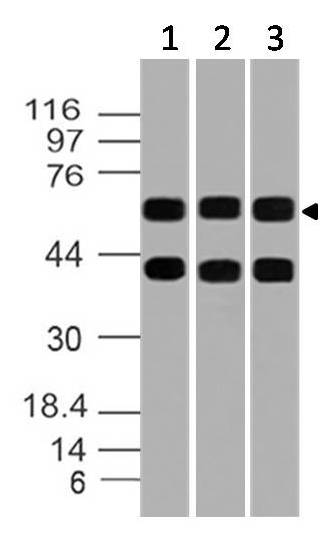Polyclonal antibody to PTPN13/PTPL1 (FAP1)

Fig:1 Western blot analysis of FAP-1 using 20-1063 at 1:2000. In ovarian carcinoma cell lines FAP-1 expression was detected in SK-OV-3 and OVCAR-3, but not in BG-1 or HEY. Human Jurkat T and 293 kidney cell lines were used as negative and positive controls, respectively.
Roll over image to zoom in
Shipping Info:
Order now and get it on Wednesday April 23, 2025
Same day delivery FREE on San Diego area orders placed by 1.00 PM
| Format : | Sera |
| Amount : | 50 µl |
| Isotype : | Rabbit IgG |
| Content : | 50 µl sera |
| Storage condition : | Store the antibody at 4°C, stable for 6 months. For long-term storage, store at -20°C. Avoid repeated freeze and thaw cycles. |
This antibody recognizes FAP-1, including FAP-1 isoforms; FAP-1 (also known as Fas-associated phosphatase-1, PTPN13, PTP-BAS, hPTPIE, and PTPL1) is a member of the protein tyrosine phosphatase (PTP) family. FAP-1 phosphatase is thought to be important in the Fas signaling pathway. FAP-1 binds to the cytosolic tail of the Fas receptor (Apo1, CD95) and inhibits Fas-induced apoptosis. Increased FAP-1 protein levels in some tumor cell lines and tumor tissues correlates with resistance to Fas-mediated apoptosis. In general, FAP-1 expression has been found to be highest in cell lines and tissues that are relatively resistant to Fas-mediated apoptosis. Gene transfer-mediated elevations in FAP-1 partially abolished Fas-induced apoptosis in a T cell line which is consistent with an inhibitory effect of FAP-1 on Fas signal transductions. Additionally, FAP-1 expression correlates with Fas resistant in ovarian cancer cell lines and FAP-1 is commonly expression in ovarian cancers.
WB: 1:1000-1:2000, IHC (paraffin): 1:1000-1:5000, IHC (frozen): Users should optimize, IP: 1:50-1:200
For Research Use Only. Not for use in diagnostic/therapeutics procedures.
| Subcellular location: | Cytoplasm, Nucleus, Cell projection |
| Tissue Specificity: | Present in most tissues with the exception of the liver and skeletal muscle. Most abundant in lung, kidney and fetal brain. |
| BioGrid: | 111747. 55 interactions. |
|
There are currently no product reviews
|
















.png)













